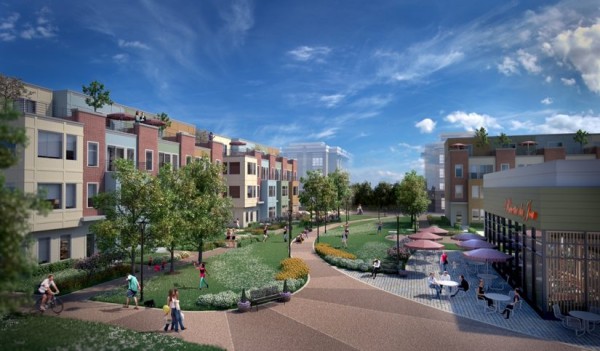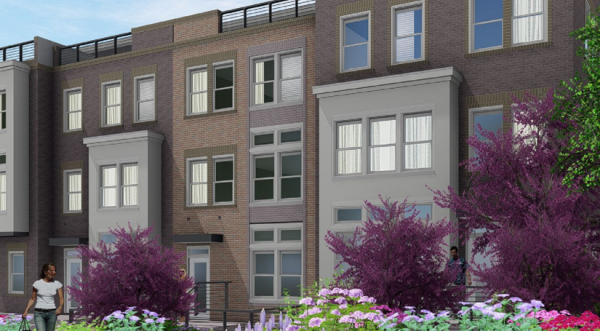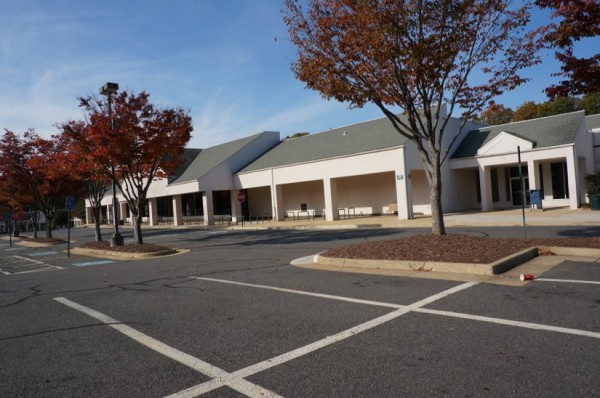The team behind the redevelopment of Tall Oaks Village Center is asking the county to amend garage size requirements so it can proceed with the redevelopment of the failing village center.
The Fairfax County Board of Supervisors approved the owner’s plan to redevelop the retail center into a mixed-use project with 156 residential units, community space, 8,500 square feet of retail and 6,000 square feet of office space. Jefferson Apartment Group purchased Tall Oaks Village Center in December 2014 for $14 million. A mix of townhouses, two-over-two townhouses, and multifamily buildings are approved for the 7.5-acre site.
Site development is expected to begin in March next year. Home construction will likely begin in October next year and be completed by the end of 2021.
In an Aug. 21 proposal submitted to the county, Stanley Martin, the contract purchaser of the property, says the county’s requirements for the size of garages, which are included in original entitlements, are too generous and create a “design challenge that is inconsistent with the planned site layout.” The county requires personal garages to have a minimum width of 11.5 feet for single-car garages and 20 feet for two-car garages.
Truett Young, vice president of land for Stanley Martin Homes, told Reston Now the following:
“There was an error in the original entitlements that created a requirement that the garages have an interior dimension that could not be achieved with the size of homes that were planned for the community. The county has standards regarding the size of parking spaces and the revised proffer language is consistent with those standards as well as the commitments that have been made on more recent projects of this type.”
Instead, the developer wants to remove the size requirement and add a commitment advising future purchasers of units to review the unit’s garage space. Covenants would also restrict the use of garages for parking, storing trash and other uses. Stanley Martin says it has received approval for garages as narrow as 10 feet in width at the Dulles Technology Center site. If the county approves the change, the development would “finally come to fruition,” wrote Mark Looney, the applicant’s representative, in a statement.
The Planning Commission will review the requested amendment on Nov. 15, followed by a public hearing before the Fairfax County Board of Supervisors on Dec. 4.
In 2007, Giant Foods, the center’s longtime anchor, closed, slowly pushing the center to slip into suburban malaise. The center’s location on a dead end and with a lack of visibility from a main street has also long remained a challenge.
Rendering via Jefferson Apartment Group
Farewell, Tall Oaks Village Center as a retail spot. Welcome, Tall Oaks Village Center as a mostly residential neighborhood.
The Fairfax County Board of Supervisors took an unprecedented step for Reston development on Tuesday when it unanimously approved Jefferson Apartment Group’s (JAG) proposal to rezone, rebuild and transform the smallest of Reston’s village centers.
JAG will now go forward with plans for 156 homes (a mix of townhomes, 2-over-2 townhomes and multifamily buildings), community space, 8,500 square foot of retail and about 6,000 square feet of office space.
“We are very excited about the approval and the chance to rejuvenate a shopping center that has been fallow for a number of years,” said JAG CEO Jim Butz. “This will be one more nice neighborhood for Reston.”
Butz said he estimated the retail site plans and permitting will be processed in the next nine months. Because the retail space will be located in existing free- standing buildings on the property, that will enable a smooth transition for current retail tenants who desire to stay at Tall Oaks.
The residential permitting process will take about 12-14 months, Butz said. Construction would begin sometime after that.
Tall Oaks’ longtime challenges have been a location on a dead end and lack of visibility from a main street. Its longtime anchor tenant, Giant Foods, moved out in 2007 and vacancies have been mounting since.
JAG representatives have said the property was marketed to retailers in the last several years but there was little interest in locating there as more than five major retail centers featuring a grocery anchor are located within a few miles.
More recently, the developer conducted a market study that showed large retail was not viable at Tall Oaks, which is now only 13 percent occupied.
“This has been a very difficult center to remodel or upgrade,” said Hunter Mill Supervisor Cathy Hudgins, who lives in the Tall Oaks area. “The hope I have is JAG is able to provide what is necessary to provide that.”
JAG paid $14 million for the property in 2014 and has held numerous meetings with the community since then. After noting community concerns, JAG has added green space and additional retail space to its original plan.
But many in the community were still not in favor of a complete overhaul for Tall Oaks. Some residents still maintain that retail would thrive at the center if it were properly managed. Read More
Will Tall Oaks Village Center get another shot at being a retail destination?
Come to a community meeting Tuesday, May 10 to find out the results of a retail study — and whether it has any impact on Jefferson Apartment Group’s (JAG) plans for the ailing shopping center.
The meeting is at 7 p.m. in the vacant anchor store space at Tall Oaks.
The future of the village center has been been a development topic for more than a year and JAG’s proposal is now scheduled to go before the Fairfax County Planning Commission on June 23.
JAG purchased Tall Oaks in December of 2014. The group held a series of community meetings in the spring of 2015, where it initially outlined plans to turn the 70,0000-square-foot center into more than 100 multifamily units and townhomes and limited (about 3,000 square feet) of retail.
Tall Oaks’s 25,000-square-foot anchor space, occupied for years by Giant Foods and then briefly by two international grocery stores, has been vacant for more than five years.
At a meeting last year, Tall Oaks representatives said at community meetings in spring of 2015 that Tall Oaks’ current retail space — which went from 90 percent occupied in 2007 to 13 percent in 2015 — was not viable.
They said they shopped the store vacancies, including grocery store space, to retailers but there was no interest.
That did not sit well with neighborhood residents, who said the center could work as retail if marketed properly. Reston Association also said in a letter to county officials last summer that the plan fell “woefully short” on retail and community space.
JAG then came back with a new proposal, which offered a reduction in the number of residences and doubled the planned retail space to 7,000 square feet.
Several Tall Oaks-area residents have said they would like to see a study done independent of the one JAG is conducting.
They have also said they would like to see about 10,000 square feet of retail, as well as more green space, on the site.
Graphic: Tall Oaks concept as of June 2015/Credit: JAG
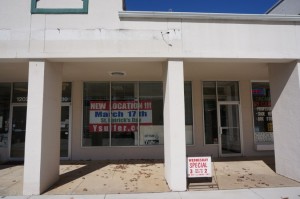 Advocacy group Reston 2020 is offering a suggestion on how the planned redevelopment at Tall Oaks Village Center could better preserve green space and add more retail to serve the neighborhood.
Advocacy group Reston 2020 is offering a suggestion on how the planned redevelopment at Tall Oaks Village Center could better preserve green space and add more retail to serve the neighborhood.
Tall Oaks Village Center is planned for redevelopment by new owner Jefferson Apartment Group (JAG). JAG is planning to make the center mostly residential, with 156 residential units (garden-style condos, townhouses and two-over-two townhouses) and up to 7,000 square foot of retail on the site of the nearly empty 70,000-square-foot village center at Wiehle Avenue and North Shore Drive.
JAG tweaked its design last spring after citizens said they were disappointed in the early plan for only about 3,000 square foot of retail. Read More
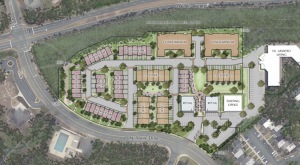 The Reston Association Board of Directors passed two motions on Wednesday relating to its role in future development at Tall Oaks Village Center and Reston Town Center North.
The Reston Association Board of Directors passed two motions on Wednesday relating to its role in future development at Tall Oaks Village Center and Reston Town Center North.
The first motion authorized RA President Ellen Graves to send a letter to Fairfax County authorities requesting that the developer, The Jefferson Apartment Group (JAG), include the Urban Land Institute’s defined standards for public plazas and meeting areas.
JAG, which purchased the ailing village center last year for $14 million, plans to redevelop it into a neighborhood of more than 140 residences, including two garden-style condo buildings, 2-over-2 townhouses and 100 traditional townhomes.
The developer said it listened to public input after the community meetings in April, when residents said there was not enough public or retail space. At a June meeting, JAG showed concept plans for double the initial retail space, a decrease in the original number of townhouses, and expanded park areas.
The Urban Land Institute has documented the importance of public-outdoor plazas and meeting areas as follows:
“A successful public realm is one in which commerce, social interaction, and leisure time activities may mix easily in an attractive, pedestrian-friendly, outdoor setting. People are drawn by the simple enjoyment of being there. If that enjoyment is to be felt, the public realm and public spaces must be well designed and programmed.
The public realm is open to programs that are significant to the community such as charity events, holiday events, and civic events. It becomes a true public place, taking on a life of its own. As part of the community that goes beyond simple commerce or public relations, it ultimately becomes a place with a history. The public realm should allow for the integration of the people, the place, and the larger community.”
Graves will send a letter to Fairfax County Hunter Mill District Supervisor Cathy Hudgins and Planning Commissioner Frank de la Fe with that request.
The board also approved a motion to allow RA counsel inform Fairfax County/INOVA that a parcel of land located in the area known as Reston Town Center North is RA-covenanted property.
RA says its wants to make clear any future development there is subject to RA Design Review Board standards and that new residents will be members of the association.
Fairfax County and Inova recently completed a land swap to organize the 49-acre space from New Dominion Parkway to Baron Cameron Avenue. The county also recently issued a Request for Proposals for the first two blocks of Town Center North.
Town Center North will be a mixed-use district, with renovated or relocated space for the Reston Regional Library and Embry Rucker Community Shelter, as well as offices, hotels, a performing arts center, an indoor recreation center, a town green and at least 1,000 new residences.
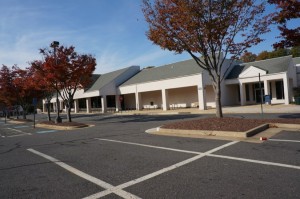 The new owners of Tall Oaks Village Center are offering Reston residents two upcoming chances to see what changes they have in store for the nearly vacant center.
The new owners of Tall Oaks Village Center are offering Reston residents two upcoming chances to see what changes they have in store for the nearly vacant center.
Tall Oaks Development Group, a division of the Jefferson Apartment Group of McLean purchased Tall Oaks in December for $14.3 million.
The Jefferson Apartment group has developed more than 18,000 rental units in 10 states, including Virginia.
Locally, the Jefferson Apartment Group has developed, among others, the Residences at the Fairfax County Government Center, Tellus in Arlington, The Asher in Alexandria and the Jefferson at 14W, a seven-story, mixed-use luxury development in Northwest DC.
Jefferson representatives, who did not return phone calls Wednesday, will hold meetings April 23 and 27 at 7 p.m. at Reston Association headquarters, 12001 Sunrise Valley Dr.
RA says Tall Oaks is being considered for a redevelopment project that would include a mix of residential and commercial uses. The Jefferson Group will provide a brief overview of the center’s history along with a proposed conceptual plan for redevelopment at the April meetings. The company will also provide comment/response cards for meeting attendees to fill out.
Tall Oaks is zoned industrial/commercial, so turning the 7.6-acre parcel into residential would likely involve rezoning, as well as approval by the RA Design Review Board, Fairfax County Planning Commission and the county Board of Supervisors.
What do do with Tall Oaks, which in the last several years has seen many tenants leave the village center without new ones opening, has been a subject discussed at length in Reston.
Last fall, residents at a Master Plan Phase 2 meeting suggested that it may be time to repurpose Tall Oaks‘ 18-acre site as something other than a retail center. The center is about a mile from the Wiehle-Reston East Metro.
The anchor space, which housed a Giant Foods and later two international grocery stores, has been empty for more than four years. The stand-alone former Burger King space has been vacant for nearly a decade. Other recent departures include El Manantial restaurant, Curves, 7-Eleven and Total Rehab Chiropractic.
It was suggested at the Phase 2 meetings last fall that Tall Oaks could survive as a convenience center with limited retail and the remaining space could be used for a variety of other purposes.
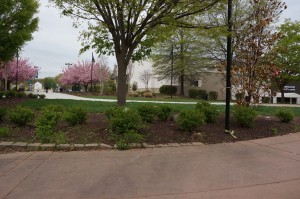 Fairfax County is getting closer to its final plan for Reston’s neighborhoods and village centers.
Fairfax County is getting closer to its final plan for Reston’s neighborhoods and village centers.
Fairfax County officials say the the current comprehensive plan, last updated in 1989, requires revision because Reston no longer has a master developer to update the plan for Reston; the plan for Reston has outdated elements; and with population expected to grow with the arrival of Metro, Reston is evolving as a community.
After nearly four years of committee work and revisions, the county Board of Supervisors in early 2014 approved Phase I of the Master Plan, which provides a framework for development in the areas surrounding Reston’s transit stations.
The county has been working on Phase 2 since last summer, holding several community meetings to obtain feedback. It is expected to get to the approval process in the next few months.
Key points of the latest draft:
Reston’s two golf courses are to remain as golf courses. This is good news for proponents of open space as the owners of Reston National Golf Course, the 166-acre public course in South Reston, head to a Fairfax County Board of Zoning Appeals hearing on Jan. 21. Owners RN Golf have inquired as to whether their zoning can be considered residential rather than recreational open space. Reston’s other course is the private Hidden Creek Country Club near Lake Anne.
The updated land use map includes areas clearly marked as open space and recreational space.
Residential land use categories have been expanded from their current three broad categories (low, medium, and high density) to five categories to more closely reflect what has been built in the community, with the desired result of maintaining established neighborhoods.
The Reston neighborhoods section provides guidance to maintain the established residential neighborhoods. In the event of residential neighborhood redevelopment requests, more stringent redevelopment criteria have been established that go beyond the County criteria.
The village centers shall remain village centers. However, should a village center want to rezone and rebuild as something else, there is also specific criteria for that. That is good news for the ailing Tall Oaks Village Center, which was purchased by an apartment developer last month.
Environmental stewardship shall remain a key focus in Reston planning.
To see the entire draft, visit the Fairfax County website.
The county will have a public meeting/presentation on the draft on 7 p.m. on Jan. 29 at Reston Community Center Lake Anne.
Photo: Hunters Woods Village Center/file photo
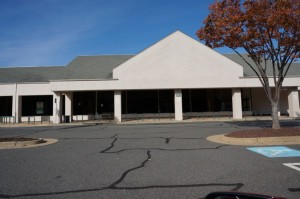 Reston Association’s Board of Directors says perhaps Tall Oaks Village Center should be re-envisioned as something else — maybe a convenience center instead of a full scale village center.
Reston Association’s Board of Directors says perhaps Tall Oaks Village Center should be re-envisioned as something else — maybe a convenience center instead of a full scale village center.
The board’s comments came in a mark up of the Reston Master Plan Phase II draft plan. The board made a series of tweaks and changes it hopes Fairfax County planners will keep in mind as it formulates a Master Plan for Reston’s village centers and neighborhoods as the community heads into its second half-century.
On Oct. 20, county planners held the second in a series of community meetings to obtain priorities and feedback on the draft proposal. The Oct. 20 meeting concentrated on the village centers — what works, what doesn’t and what should be considered for the future.
The focus groups seemed to agree — Tall Oaks has been failing for years. With storefronts sitting empty for years and no new ones opening, it may be time to rezone some of the land to something else keeping some of Tall Oaks a “convenience center” or a mini village center.
Reston Association agrees.
From notes issued by RA to the county planners:
Reston was originally planned with Village Centers serving as the focal point of activity for the surrounding neighborhoods.
FOUR of the five existing village centers – Lake Anne, Hunters Woods, South Lakes and North Point (Tall Oaks is crossed out) are planned to continue to serve this purpose in the future. They are planned to allow currently approved intensities and to densities to remain but are envisioned to also accommodate some more intense vertical use redevelopment in the future to fully achieve the goal of being vibrant centers of activity.
Other suggestions from the document:
Senior housing and universal design residences are encouraged to be located within the village centers.
Tall Oaks is the smallest of the five Village Centers. Consideration should be given as a re-designation of this center as a smaller convenience center.
Other opinions of note from RA’s comments:
Reston has, since its inception, been envisioned to be a place to live, work, play and get involved. The overriding goal of the Plan is for Reston to continue to evolve in a sustainable manner over the next four or five decades. … As Reston evolves, it is important to respect and continue the characteristics that have helped define Reston from its inception.
As Reston’s population increases, added capacity should be achieved through development of land and/or facilities to meet the demands (not needs) generated by the development or redevelopment.
Protect the headwater areas and other environmentally sensitive areas through the implementation of innovative stormwater management practices and Reston Association’s stream restoration/preservation program.
Increase senior housing, ensure opportunities are provided for adequate senior housing designed to suit a range of age, income and health needs.
Wherever possible, missing connections in the pedestrian and bicycle networks should be rectified with new sidewalks, bike lanes (shared or separate) or trails.
Should the Hunt Club property be redeveloped residential, it should be part of Reston Association.
The Lake Newport Convenience Center designation should be deleted and the land is planned for office use at the existing density to maintain character.
To see the entire document, visit Reston Association’s website.
 Winter has come early this season! Being a snow lover, I welcome this early taste of the white stuff.
Winter has come early this season! Being a snow lover, I welcome this early taste of the white stuff.
Certainly, it’s a welcome change from the largely barren winters we’ve had the last couple of years. The snow and ice meant a surprise four-day weekend for my daughter Leslie. For my wife and me, this meant working from home.
While I was tapping away on my computer and watching the flakes fall, I thought about the phenomenon of telecommuting. It’s pretty remarkable that technology has advanced to the point where we can be practically as productive outside the office as in it.
One of Bob Simon’s founding principles for Reston was that “the people be able to live and work in the same community.” In a way, telecommuting is the ultimate version of that goal: people living and working in the same house. And there are people who think that this is the future: widespread telecommuting will be what saves us from traffic paralysis and environmental degradation.
Maybe they’re right. But the move toward telecommuting is emblematic of a troubling trend in our society, toward less face-to-face human interaction. That trend runs the risk of damaging our sense of community.
We live in an increasingly atomized society; we spend less and less time in the company of others. For a lot of folks, life is a continuous cycle: from home to work to shopping and back home again. With the new self-checkout feature at grocery stores, you can get in and get out without having to talk to another person at all. It’s a lonely way to live.
Civic and fellowship organizations are a lot less popular than they used to be; so is going out for bridge night. Many of today’s leisure activities can be done at home alone (video games, surfing the
Internet, etc.). Lots of people work out at the gym, but that’s a solitary pursuit too, a time to plug in the headphones and unwind from (or get ready for) the day.
The office is one of the few places where we really spend time with people outside of our families anymore. If we’re no longer going into the office every day, what happens then? We are social creatures; instant messaging and video conferencing aren’t a real substitute for face-to-face contact as our primary source of human interaction.


